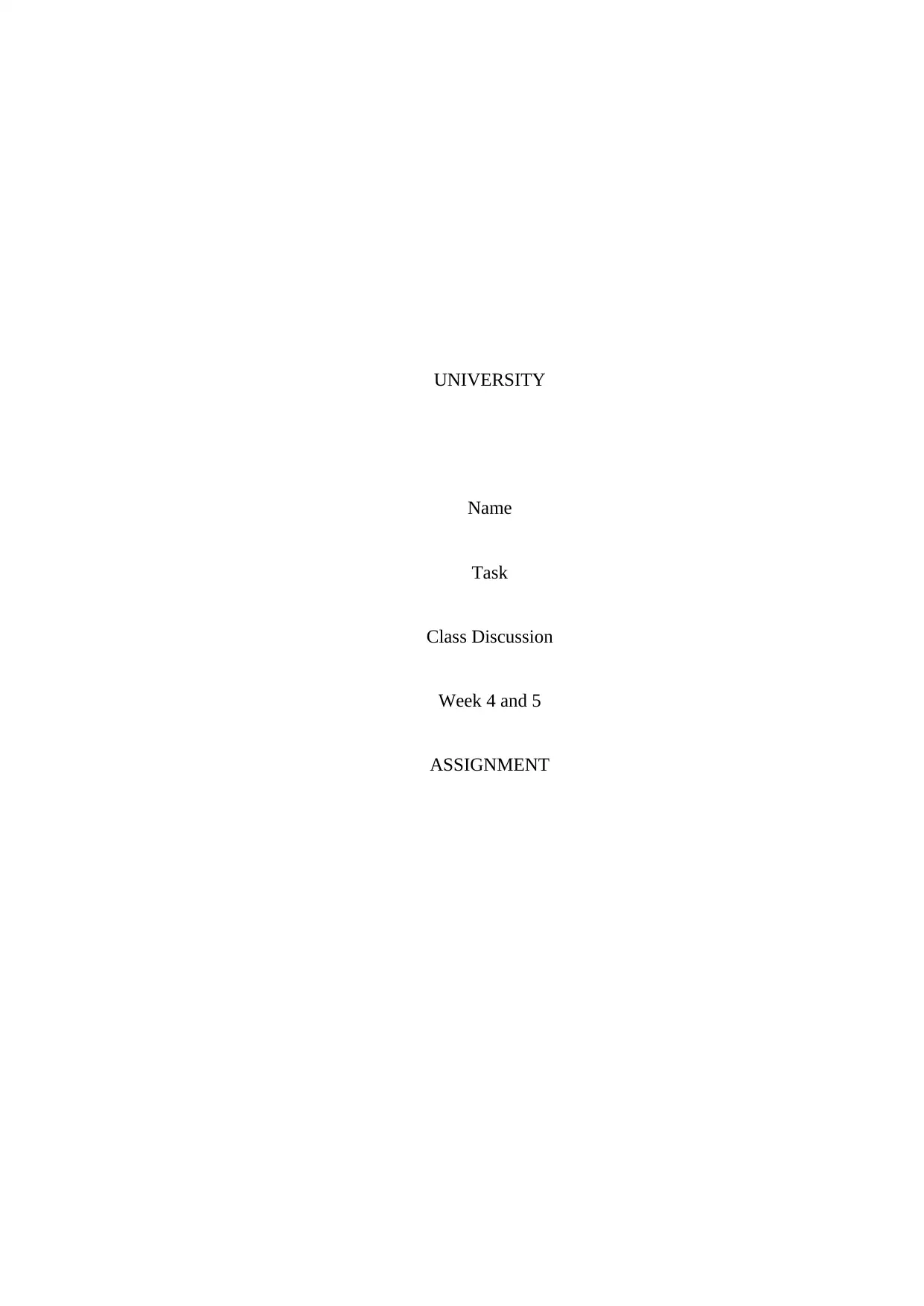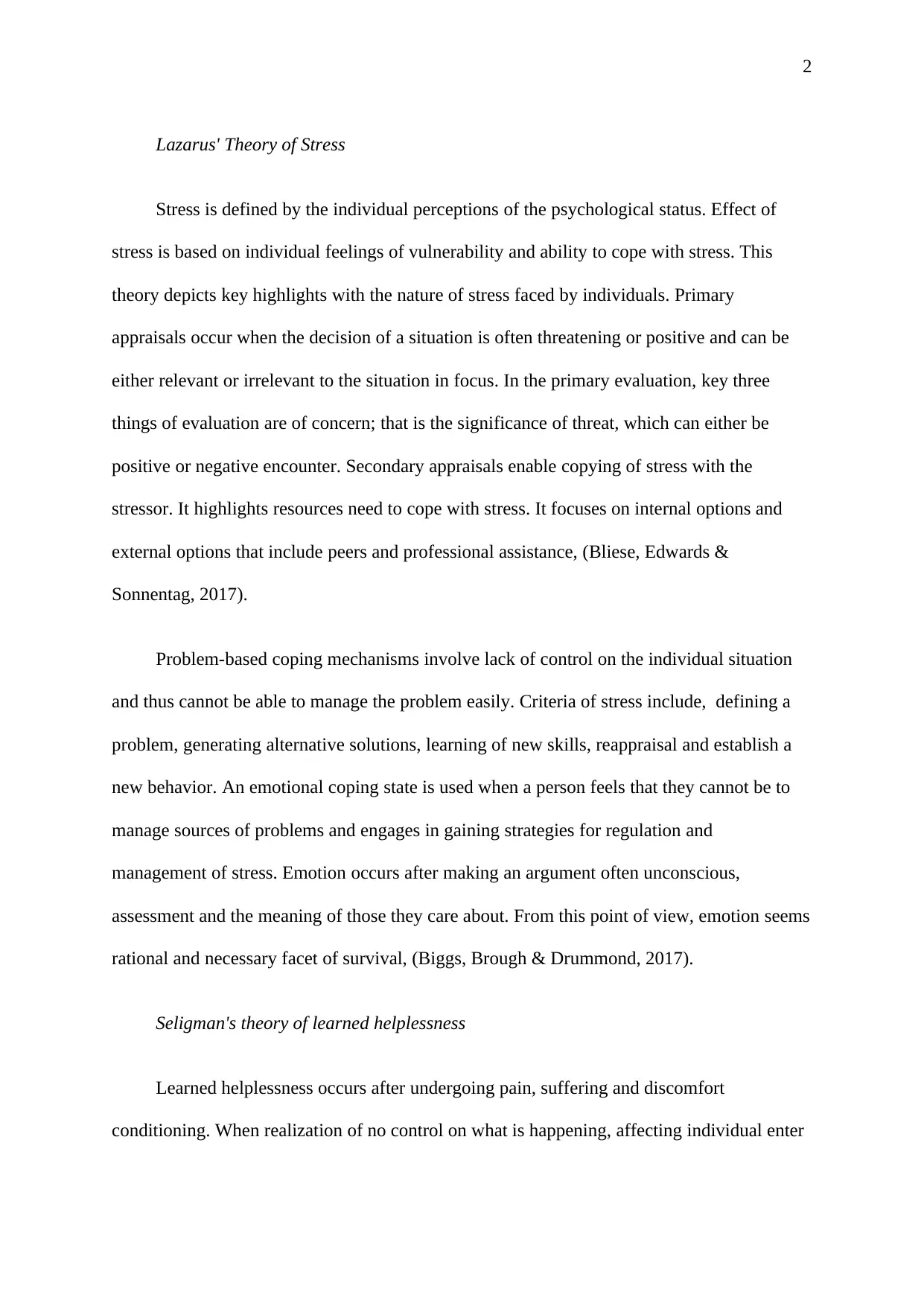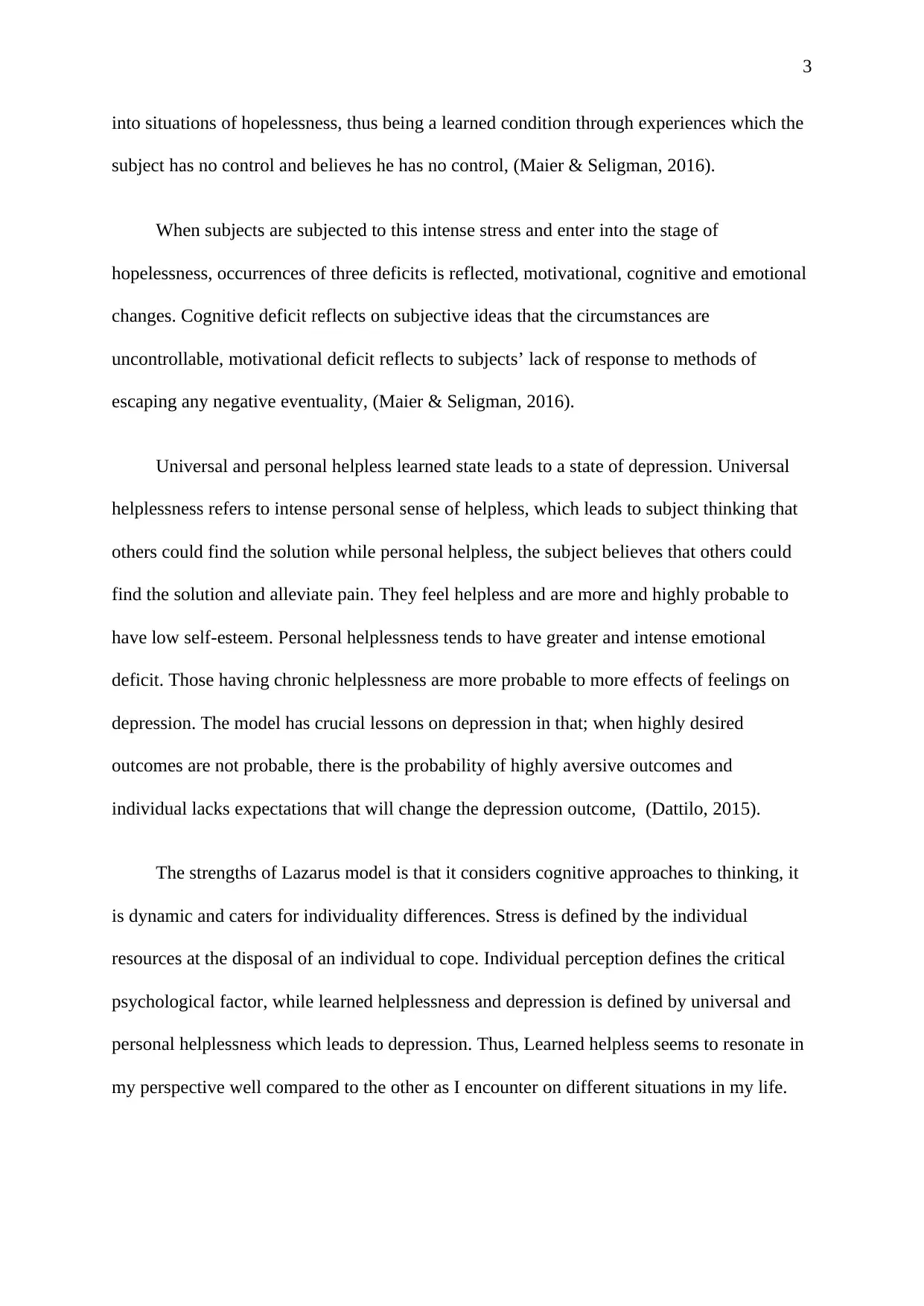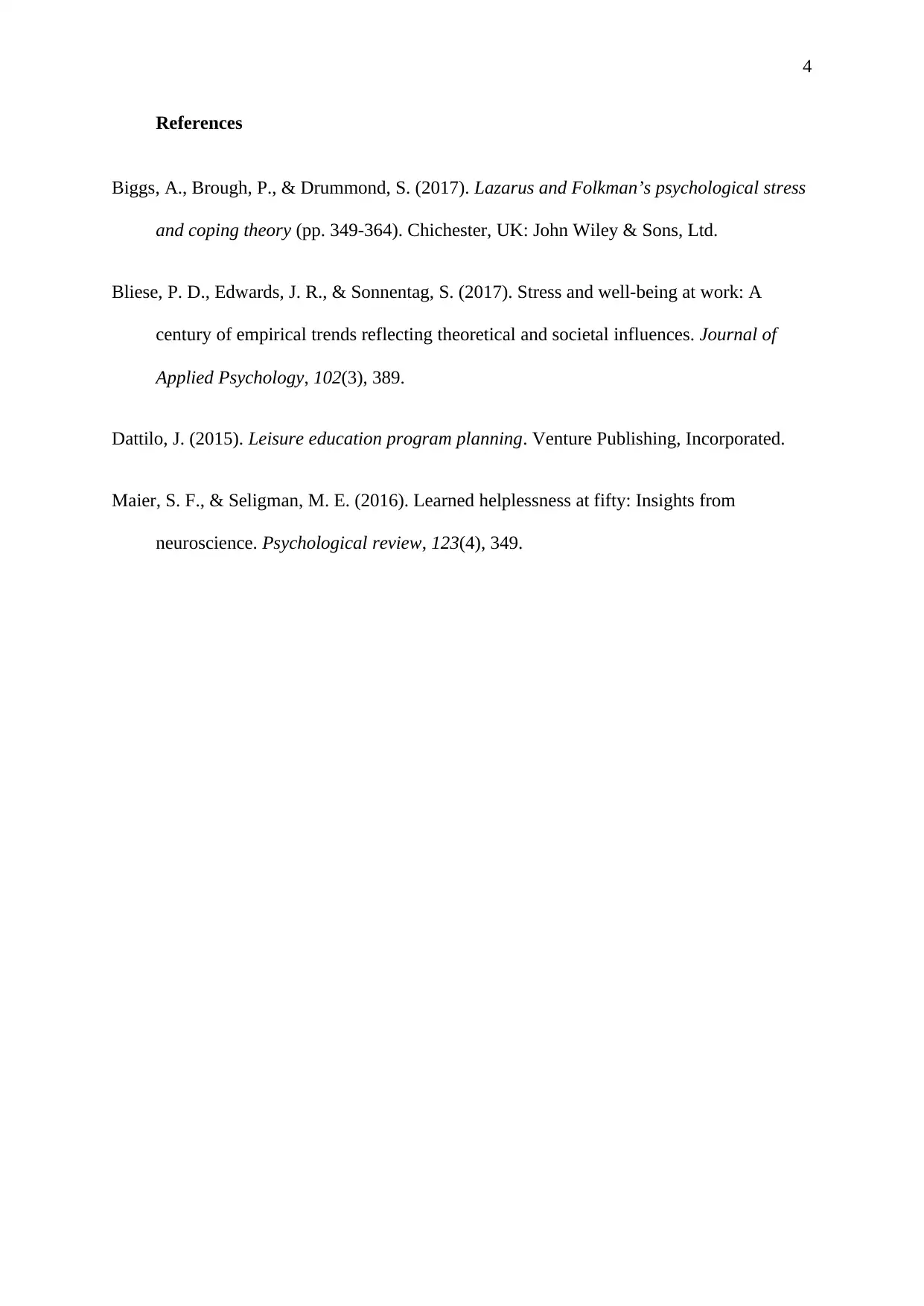A Comparative Study: Lazarus' Stress Theory & Seligman's Helplessness
VerifiedAdded on 2023/05/29
|4
|781
|345
Discussion Board Post
AI Summary
This discussion post compares Lazarus' theory of stress, which emphasizes individual perceptions and coping mechanisms through primary and secondary appraisals, with Seligman's theory of learned helplessness, which explains how individuals may develop motivational, cognitive, and emotional deficits after experiencing uncontrollable negative events. The post discusses problem-based and emotion-focused coping strategies within Lazarus' model and differentiates between universal and personal helplessness in Seligman's theory, linking it to depression. It highlights the strengths of Lazarus' model in considering cognitive approaches and individual differences, while also reflecting on the personal relevance of learned helplessness.

UNIVERSITY
Name
Task
Class Discussion
Week 4 and 5
ASSIGNMENT
Name
Task
Class Discussion
Week 4 and 5
ASSIGNMENT
Paraphrase This Document
Need a fresh take? Get an instant paraphrase of this document with our AI Paraphraser

2
Lazarus' Theory of Stress
Stress is defined by the individual perceptions of the psychological status. Effect of
stress is based on individual feelings of vulnerability and ability to cope with stress. This
theory depicts key highlights with the nature of stress faced by individuals. Primary
appraisals occur when the decision of a situation is often threatening or positive and can be
either relevant or irrelevant to the situation in focus. In the primary evaluation, key three
things of evaluation are of concern; that is the significance of threat, which can either be
positive or negative encounter. Secondary appraisals enable copying of stress with the
stressor. It highlights resources need to cope with stress. It focuses on internal options and
external options that include peers and professional assistance, (Bliese, Edwards &
Sonnentag, 2017).
Problem-based coping mechanisms involve lack of control on the individual situation
and thus cannot be able to manage the problem easily. Criteria of stress include, defining a
problem, generating alternative solutions, learning of new skills, reappraisal and establish a
new behavior. An emotional coping state is used when a person feels that they cannot be to
manage sources of problems and engages in gaining strategies for regulation and
management of stress. Emotion occurs after making an argument often unconscious,
assessment and the meaning of those they care about. From this point of view, emotion seems
rational and necessary facet of survival, (Biggs, Brough & Drummond, 2017).
Seligman's theory of learned helplessness
Learned helplessness occurs after undergoing pain, suffering and discomfort
conditioning. When realization of no control on what is happening, affecting individual enter
Lazarus' Theory of Stress
Stress is defined by the individual perceptions of the psychological status. Effect of
stress is based on individual feelings of vulnerability and ability to cope with stress. This
theory depicts key highlights with the nature of stress faced by individuals. Primary
appraisals occur when the decision of a situation is often threatening or positive and can be
either relevant or irrelevant to the situation in focus. In the primary evaluation, key three
things of evaluation are of concern; that is the significance of threat, which can either be
positive or negative encounter. Secondary appraisals enable copying of stress with the
stressor. It highlights resources need to cope with stress. It focuses on internal options and
external options that include peers and professional assistance, (Bliese, Edwards &
Sonnentag, 2017).
Problem-based coping mechanisms involve lack of control on the individual situation
and thus cannot be able to manage the problem easily. Criteria of stress include, defining a
problem, generating alternative solutions, learning of new skills, reappraisal and establish a
new behavior. An emotional coping state is used when a person feels that they cannot be to
manage sources of problems and engages in gaining strategies for regulation and
management of stress. Emotion occurs after making an argument often unconscious,
assessment and the meaning of those they care about. From this point of view, emotion seems
rational and necessary facet of survival, (Biggs, Brough & Drummond, 2017).
Seligman's theory of learned helplessness
Learned helplessness occurs after undergoing pain, suffering and discomfort
conditioning. When realization of no control on what is happening, affecting individual enter

3
into situations of hopelessness, thus being a learned condition through experiences which the
subject has no control and believes he has no control, (Maier & Seligman, 2016).
When subjects are subjected to this intense stress and enter into the stage of
hopelessness, occurrences of three deficits is reflected, motivational, cognitive and emotional
changes. Cognitive deficit reflects on subjective ideas that the circumstances are
uncontrollable, motivational deficit reflects to subjects’ lack of response to methods of
escaping any negative eventuality, (Maier & Seligman, 2016).
Universal and personal helpless learned state leads to a state of depression. Universal
helplessness refers to intense personal sense of helpless, which leads to subject thinking that
others could find the solution while personal helpless, the subject believes that others could
find the solution and alleviate pain. They feel helpless and are more and highly probable to
have low self-esteem. Personal helplessness tends to have greater and intense emotional
deficit. Those having chronic helplessness are more probable to more effects of feelings on
depression. The model has crucial lessons on depression in that; when highly desired
outcomes are not probable, there is the probability of highly aversive outcomes and
individual lacks expectations that will change the depression outcome, (Dattilo, 2015).
The strengths of Lazarus model is that it considers cognitive approaches to thinking, it
is dynamic and caters for individuality differences. Stress is defined by the individual
resources at the disposal of an individual to cope. Individual perception defines the critical
psychological factor, while learned helplessness and depression is defined by universal and
personal helplessness which leads to depression. Thus, Learned helpless seems to resonate in
my perspective well compared to the other as I encounter on different situations in my life.
into situations of hopelessness, thus being a learned condition through experiences which the
subject has no control and believes he has no control, (Maier & Seligman, 2016).
When subjects are subjected to this intense stress and enter into the stage of
hopelessness, occurrences of three deficits is reflected, motivational, cognitive and emotional
changes. Cognitive deficit reflects on subjective ideas that the circumstances are
uncontrollable, motivational deficit reflects to subjects’ lack of response to methods of
escaping any negative eventuality, (Maier & Seligman, 2016).
Universal and personal helpless learned state leads to a state of depression. Universal
helplessness refers to intense personal sense of helpless, which leads to subject thinking that
others could find the solution while personal helpless, the subject believes that others could
find the solution and alleviate pain. They feel helpless and are more and highly probable to
have low self-esteem. Personal helplessness tends to have greater and intense emotional
deficit. Those having chronic helplessness are more probable to more effects of feelings on
depression. The model has crucial lessons on depression in that; when highly desired
outcomes are not probable, there is the probability of highly aversive outcomes and
individual lacks expectations that will change the depression outcome, (Dattilo, 2015).
The strengths of Lazarus model is that it considers cognitive approaches to thinking, it
is dynamic and caters for individuality differences. Stress is defined by the individual
resources at the disposal of an individual to cope. Individual perception defines the critical
psychological factor, while learned helplessness and depression is defined by universal and
personal helplessness which leads to depression. Thus, Learned helpless seems to resonate in
my perspective well compared to the other as I encounter on different situations in my life.
⊘ This is a preview!⊘
Do you want full access?
Subscribe today to unlock all pages.

Trusted by 1+ million students worldwide

4
References
Biggs, A., Brough, P., & Drummond, S. (2017). Lazarus and Folkman’s psychological stress
and coping theory (pp. 349-364). Chichester, UK: John Wiley & Sons, Ltd.
Bliese, P. D., Edwards, J. R., & Sonnentag, S. (2017). Stress and well-being at work: A
century of empirical trends reflecting theoretical and societal influences. Journal of
Applied Psychology, 102(3), 389.
Dattilo, J. (2015). Leisure education program planning. Venture Publishing, Incorporated.
Maier, S. F., & Seligman, M. E. (2016). Learned helplessness at fifty: Insights from
neuroscience. Psychological review, 123(4), 349.
References
Biggs, A., Brough, P., & Drummond, S. (2017). Lazarus and Folkman’s psychological stress
and coping theory (pp. 349-364). Chichester, UK: John Wiley & Sons, Ltd.
Bliese, P. D., Edwards, J. R., & Sonnentag, S. (2017). Stress and well-being at work: A
century of empirical trends reflecting theoretical and societal influences. Journal of
Applied Psychology, 102(3), 389.
Dattilo, J. (2015). Leisure education program planning. Venture Publishing, Incorporated.
Maier, S. F., & Seligman, M. E. (2016). Learned helplessness at fifty: Insights from
neuroscience. Psychological review, 123(4), 349.
1 out of 4
Related Documents
Your All-in-One AI-Powered Toolkit for Academic Success.
+13062052269
info@desklib.com
Available 24*7 on WhatsApp / Email
![[object Object]](/_next/static/media/star-bottom.7253800d.svg)
Unlock your academic potential
Copyright © 2020–2025 A2Z Services. All Rights Reserved. Developed and managed by ZUCOL.





